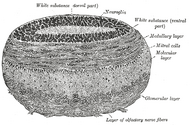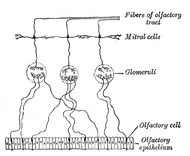Assessment |
Biopsychology |
Comparative |
Cognitive |
Developmental |
Language |
Individual differences |
Personality |
Philosophy |
Social |
Methods |
Statistics |
Clinical |
Educational |
Industrial |
Professional items |
World psychology |
Biological: Behavioural genetics · Evolutionary psychology · Neuroanatomy · Neurochemistry · Neuroendocrinology · Neuroscience · Psychoneuroimmunology · Physiological Psychology · Psychopharmacology (Index, Outline)
| Glomerulus (olfaction) | ||
|---|---|---|
| Coronal section of olfactory bulb. | ||
| Latin | ' | |
| Gray's | subject #189 848 | |
| System | ||
| MeSH | [1] | |
| Plan of olfactory neurons. | ||
The glomerulus (plural glomeruli) in olfaction is a structure in the olfactory bulb. It is made up of a globular tangle of axons from the olfactory receptor neurons in the olfactory epithelium and dendrites from the mitral cells, tufted cells, and other cell types.
Glomeruli are important waystations in the pathway from the nose to the olfactory cortex. Each glomerulus receives input from olfactory receptor neurons expressing only one type of olfactory receptor. There are tens of millions of olfactory receptor cells, but only about two thousand glomeruli. In a remarkable example of convergence, glomeruli receive input from between five thousand and ten thousand olfactory receptor cells but only output onto ten to twenty five mitral cells. By combining so much input, the olfactory system is able to detect even very faint odors.
Besides the mitral cell dendrites, the dendrites of other cell types, known collectively as juxtaglomerular cells also synapse at the glomerulus. These juxtaglomerular cells, which include so-called short axon cells and periglomerular cells are mainly GABA-ergic. They may be involved in feedback or lateral inhibition.
The glomerulus is the basic unit in the odor map of the olfactory bulb. Each odor activates a different pattern of glomeruli, such that simply by analyzing the different sets of activated glomeruli, one could theorectically decode the identity of the odor. Since input from different glomeruli converge in the piriform cortex the decyphering of the odor code could be the role of the piriform, but this has not been conclusively established.
Template:EnWP)

